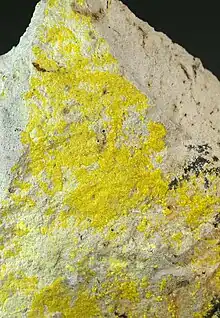Weeksite
Weeksite is a naturally occurring uranium silicate mineral with the chemical formula: K2(UO2)2Si6O15•4(H2O), potassium uranyl silicate. Weeksite has a Mohs hardness of 1-2. It was named for USGS mineralogist Alice Mary Dowse Weeks (1909–1988).[3][4]
| Weeksite | |
|---|---|
 | |
| General | |
| Category | Silicate mineral |
| Formula (repeating unit) | K2(UO2)2Si6O15·4(H2O) |
| IMA symbol | Wks[1] |
| Strunz classification | 9.AK.30 |
| Crystal system | Orthorhombic |
| Crystal class | Dipyramidal (mmm) H-M symbol: (2/m 2/m 2/m) |
| Space group | Pnnb (no. 52) |
| Unit cell | a = 14.26 Å, b = 35.88 Å c = 14.2 Å; Z = 16 |
| Identification | |
| Colour | Yellow |
| Crystal habit | Occurs as acicular to elongated bladed crystals, flattened on {010}, also as radiating fibrous clusters and spherulites, pseudotetragonal |
| Cleavage | Distinct prismatic |
| Mohs scale hardness | 1 - 2 |
| Lustre | Waxy to silky |
| Streak | Yellow |
| Diaphaneity | Transparent to translucent |
| Specific gravity | 4.1 |
| Optical properties | Biaxial (-) |
| Refractive index | nα = 1.596 nβ = 1.603 nγ = 1.606 |
| Birefringence | δ = 0.010 |
| Pleochroism | X = colorless; Y = pale yellow-green; Z = yellow-green |
| 2V angle | Measured: 60° |
| Other characteristics | |
| References | [2][3][4] |
Appearance
Weeksite is visually similar to other uranium minerals such as carnotite and zippeite, both being encrustations that form on other rocks (usually sandstones or limestones).
Occurrence
Weeksite was first described in 1960 for an occurrence on Topaz Mountain, Thomas Range, Juab County, Utah.[2]
Weeksite occurs within small "opal" veins within rhyolite and agglomerates, and as encrustations in sandstones and limestones. It occurs associated with opal, chalcedony, calcite, gypsum, fluorite, uraninite, thorogummite, uranophane, boltwoodite, carnotite and margaritasite.[3]
See also
- Mineral evolution
- List of minerals – List of minerals with Wikipedia articles
- List of minerals named after people
References
- Warr, L.N. (2021). "IMA–CNMNC approved mineral symbols". Mineralogical Magazine. 85 (3): 291–320. Bibcode:2021MinM...85..291W. doi:10.1180/mgm.2021.43. S2CID 235729616.
- "Weeksite mineral information and data". Mindat.org. 2011-06-19. Retrieved 2012-02-10.
- Handbook of Mineralogy
- Webmineral data for weeksite